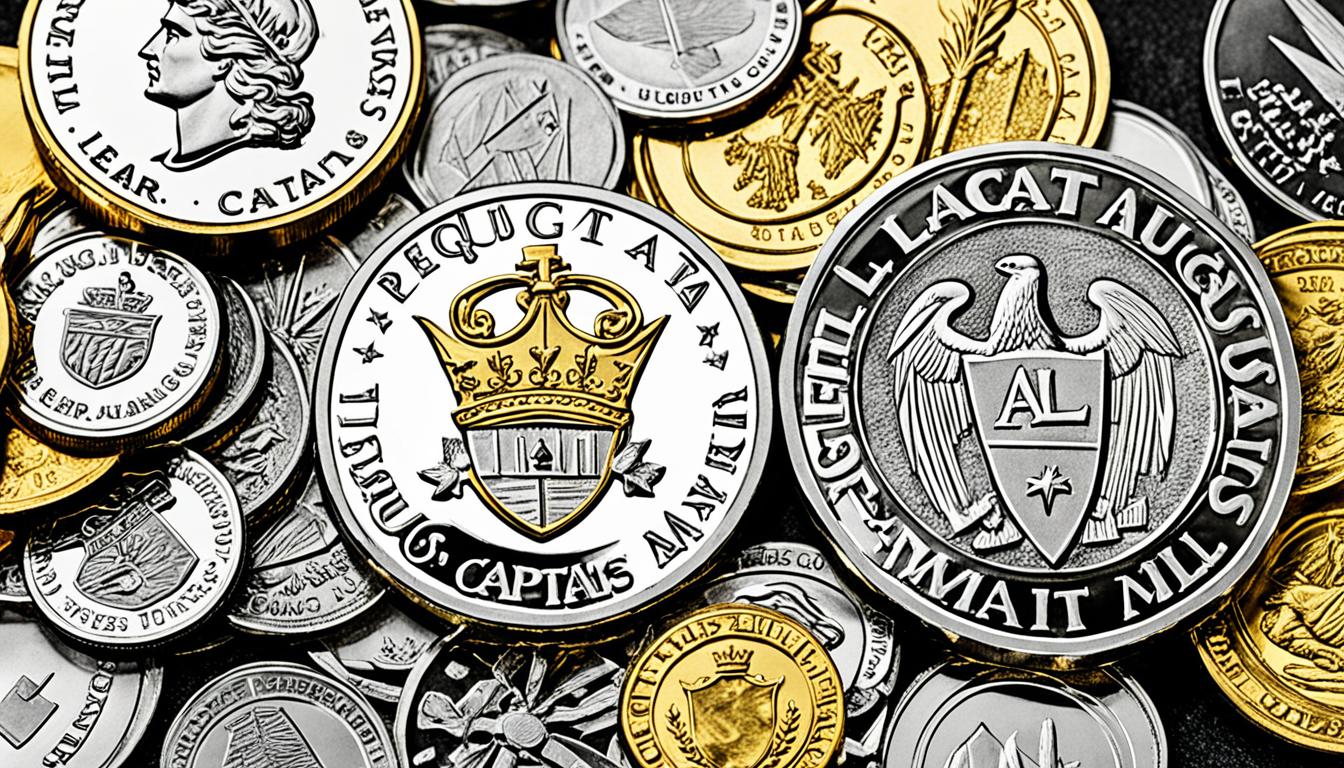To diversify your retirement savings and protect against economic uncertainties and inflation, consider rolling over a portion of your 401k into a Gold IRA. This type of individual retirement account allows you to invest in physical gold or other precious metals, helping to enhance portfolio diversification. This can be an effective strategy to strengthen your retirement savings plan.
Key Takeaways
- Consider a direct rollover to a Gold IRA for tax efficiency.
- Research reputable Gold IRA companies for guidance.
- Evaluate risks and benefits of investing in gold.
- Ensure compliance with IRS guidelines for retirement accounts.
- Seek professional advice from a financial advisor familiar with gold investments.
Gold IRA Basics

If you're considering diversifying your retirement portfolio, understanding the basics of a Gold IRA is essential. A Gold IRA account is a retirement savings plan that holds physical gold or other precious metals instead of traditional financial assets like stocks. One of the key advantages of a Gold IRA is its ability to act as a hedge against inflation and economic downturns. Additionally, Gold IRAs offer tax advantages that can help you maximize your savings over time.
When setting up a Gold IRA, it's important to consult with a reputable Gold IRA company that can guide you through the process. These companies can help you explore different investment options and make sure that your precious metals are stored securely. It's worth noting that Gold IRAs may come with higher storage costs compared to traditional IRAs due to the physical nature of the assets involved. By working with a trusted Gold IRA company, you can make informed decisions about diversifying your retirement savings effectively.
401(k) Rollover Options

When contemplating rollover options for your 401(k) into a Gold IRA, it's vital to comprehend the differences between direct and indirect rollovers. Direct rollover involves transferring funds directly from a 401(k) to a gold IRA, minimizing paperwork and tax risks. On the other hand, an indirect rollover requires withdrawing funds from a 401(k) and depositing them into a gold IRA within a 60-day window. Here are key points to ponder:
- Direct rollovers are preferred for their simplicity and reduced tax implications.
- Indirect rollovers offer short-term access to funds but come with the risk of missing the 60-day window, leading to tax penalties.
- Choose between direct and indirect rollovers based on your individual needs and circumstances to ensure a smooth shift of your retirement savings into a Gold IRA. Remember to take into account the timing, tax implications, and your financial goals when deciding on the rollover method that best suits your situation.
Investing in Gold Mutual Funds

When contemplating investing in gold mutual funds for your 401(k), it's crucial to understand the basics, benefits, and risks involved.
These funds offer exposure to the gold market through investments in gold mining companies and related assets, providing diversification to your portfolio.
As you evaluate different options like Fidelity Select Gold Portfolio (FSAGX), be sure to weigh factors such as expense ratios and fund performance to make informed decisions.
Gold Mutual Funds Basics
Investors can access the gold market through professionally managed mutual funds that focus on companies involved in gold mining and production. Gold mutual funds offer exposure to the precious metal without the need to purchase physical gold.
When considering these funds, investors should pay attention to expense ratios, as they can impact overall returns. Examples like the Fidelity Select Gold Portfolio (FSAGX) provide a way to invest in a diversified portfolio of gold-related companies.
Benefits of Investing
Shifting your focus to the benefits of investing in gold mutual funds, you can gain exposure to the gold sector within your 401(k) while potentially enjoying diversification and indirect exposure to the price of gold.
By investing in gold mutual funds like the Fidelity Select Gold Portfolio (FSAGX), you're essentially investing in gold mining companies, providing a way to diversify your 401(k) with assets tied to the gold industry.
It's important to take into account expense ratios when selecting a gold mutual fund to guarantee cost-effectiveness. These funds offer a convenient avenue for gaining indirect exposure to the price movements of gold without needing to own physical gold, making them a strategic addition to your investment portfolio within your retirement account.
Risks to Consider
Considering the market risks associated with gold price fluctuations and fund performance, investing in gold mutual funds requires careful evaluation of potential drawbacks. When considering these investments, keep in mind the following:
- Performance: The performance of gold mutual funds can be influenced by various factors such as geopolitical events, economic trends, and mining operations.
- Expense Ratios: High expense ratios can eat into your returns, so it's important to compare fees when selecting a fund.
- Management Team and Investment Strategy: Evaluate the fund's historical performance, investment strategy, and the expertise of the management team to make informed decisions about incorporating gold mutual funds into your portfolio.
Exploring Gold ETFs

Exploring Gold ETFs offers a convenient way to gain exposure to the price of gold within your investment portfolio without the need for physical ownership. Gold ETFs, or exchange-traded funds, are designed to track the price of gold, allowing investors to benefit from its price movements. However, it's important to be mindful that these ETFs come with management fees and expenses that can impact how well they track the actual price of gold.
Examples like iShares Gold ETF (CSGOLD) and Sprott Gold Miners ETF (SGDM) offer different approaches to investing in gold through ETFs.
When considering incorporating gold ETFs into your 401(k) plan, it's crucial to evaluate the potential risks and benefits they present. While they can provide a convenient way to add gold exposure to your retirement savings, make sure they align with your investment strategy. Take the time to understand how these ETFs work and assess whether they fit your long-term financial goals before making any decisions.
Setting Up Self-Directed IRA

When setting up a self-directed IRA, you'll need to meet specific eligibility criteria, consider the investment options available, and go through a custodian selection process.
This process involves understanding the rules and requirements, completing necessary paperwork, and funding the account accordingly.
Collaborating with a reputable gold IRA company can provide guidance on maneuvering the complexities of setting up a self-directed IRA.
IRA Eligibility Criteria
To qualify for setting up a self-directed IRA for investing in physical gold, you must meet specific age and income requirements. When considering IRA eligibility criteria, keep the following in mind:
- Age Requirement: Typically, you need to be at least 18 years old to open a self-directed IRA.
- Income Threshold: Some self-directed IRAs may have minimum income requirements for eligibility.
- Consult with a Custodian: Working with a self-directed IRA custodian is essential for understanding IRS regulations and facilitating investments in physical gold.
Ensure you fulfill these criteria to enjoy the investment flexibility that self-directed IRAs offer when venturing into alternative investments like physical gold.
Investment Options Available
Consider diversifying your retirement portfolio by exploring investment options available through setting up a self-directed IRA. Self-directed IRAs permit investing in physical gold bullion or coins, expanding opportunities for gold investments through the rollover process from a 401(k). Unlike traditional IRAs, self-directed IRAs offer the flexibility to directly invest in physical gold, allowing for increased control over investments. In-service withdrawals from a 401(k) can facilitate the rollover process to a self-directed IRA, enabling diversification with alternative assets like physical gold. This avenue opens up new investment options within your retirement account, providing the potential benefits of holding physical gold as part of your long-term financial strategy.
| Investment Options | Benefits |
|---|---|
| Physical Gold | Diversification and hedge against inflation |
| Alternative Assets | Increased control over investment choices |
Custodian Selection Process
For selecting a custodian to set up your self-directed IRA, prioritize identifying an IRS-approved custodian with a proven track record in securely storing precious metals such as physical gold. When choosing a custodian for your gold IRA, consider the following:
- Verify the custodian's reputation and track record for secure storage of precious metals.
- Confirm that the custodian provides storage facilities like banks or depositories for your gold assets.
- Validate that the custodian complies with IRS guidelines for precious metal IRAs, guaranteeing a smooth and compliant investment process.
Evaluating Risks and Benefits

Evaluating the risks and benefits of putting your 401(k) into gold can provide valuable insights into its potential impact on your investment portfolio. When contemplating this investment option, it's essential to weigh the advantages and disadvantages thoughtfully. Below is a table outlining key factors to ponder:
| Factors | Description |
|---|---|
| Diversification | Gold offers a low correlation with traditional assets, aiding portfolio diversification. |
| Inflation Hedge | Investing in gold can act as a hedge against inflation, preserving purchasing power. |
| Currency Fluctuations | Gold may help mitigate risks associated with currency fluctuations. |
| Storage Costs | Physical gold storage costs can impact overall investment returns. |
Understanding these factors will assist you in making an informed decision regarding incorporating gold into your 401(k) investment. Remember, while gold can provide protection, its value fluctuates based on market conditions, and it doesn't generate dividends or interest like other investments.
Seeking Professional Advice

When considering putting your 401(k) into gold, it's important to consult a financial advisor knowledgeable about retirement accounts. Research reputable firms and verify the credentials of the advisor you choose.
Seeking professional advice can provide you with valuable insights into the potential benefits, risks, and tax implications of transferring your retirement funds into a gold IRA.
Consult Financial Advisor
Seeking professional advice from a financial advisor is essential before considering putting your 401(k) into gold. When consulting a financial advisor regarding this decision, you can expect the following:
- Comprehensive Evaluation: Your financial advisor will assess your current retirement savings, financial goals, and risk tolerance to determine if gold investment aligns with your objectives.
- Risk Analysis: They'll provide insights into the potential risks associated with shifting a portion of your 401(k) into gold, helping you understand the volatility and security of this investment option.
- Tax Implications: Your advisor will explain the tax consequences of moving funds into gold, ensuring you're aware of any tax advantages or liabilities that may arise from this strategic shift.
Research Reputable Firms
Consider beginning your research by looking for firms with a strong reputation in handling gold IRA accounts.
When exploring financial institutions to entrust your retirement funds in gold, evaluate their experience in managing gold investments and their track record.
It's important to choose a reputable firm that offers transparent fee structures, excellent customer service, and secure storage options for physical gold holdings.
Make sure that the firm aligns with your retirement plan objectives and understands the tax implications of investing in gold within an IRA.
Verify Advisor Credentials
To guarantee a successful conversion of your 401(k) into gold, prioritize confirming the credentials and experience of your financial advisor in gold investments and retirement accounts.
When verifying advisor credentials, consider the following:
- Look for financial advisors with specialized knowledge in gold investments and retirement accounts.
- Verify the advisor's credentials, certifications, and experience in handling 401(k) to gold conversions.
- Seek advisors who understand the intricacies of IRS regulations regarding gold investments in retirement accounts.
Monitoring Market Trends
To effectively monitor market trends for gold, start by checking gold prices daily and keeping a close eye on any changes. By staying informed about gold prices, you can identify potential buying opportunities and make informed decisions.
Utilize technical analysis tools to spot patterns and trends in the gold market, providing valuable insights into potential price movements. Additionally, following expert opinions and forecasts from reliable sources can offer a broader perspective on market trends.
Consider setting up price alerts or using trading platforms to receive real-time updates on gold prices, enabling you to act swiftly when opportunities arise. Geopolitical events and economic indicators also play an important role in influencing gold prices, so staying abreast of these factors is essential for monitoring market trends effectively.
Diversifying Gold Investments

When diversifying your 401(k) into gold, explore various investment options to mitigate risks and seize potential opportunities.
Here are three key ways to diversify your gold investments effectively:
- Consider a self-directed IRA: Investing in gold through a self-directed IRA allows you to have more control over your retirement funds and choose from a wider range of investment options, including physical gold.
- Consult with a financial advisor: Seeking advice from a financial advisor can help you understand the implications of diversifying your portfolio with gold, including the risks and potential benefits it may offer for your retirement plans.
- Explore gold mutual funds and ETFs: Gold mutual funds and exchange-traded funds (ETFs) provide alternative ways to invest in gold without the need to physically own the precious metal, offering flexibility and diversification within your portfolio.
Long-Term Financial Goals

Establishing clear long-term financial goals is vital for guiding your decision-making process and making sure that your investments align with your desired retirement outcomes. When considering your individual retirement account (IRA) and the option to invest in the ownership of physical gold through gold IRAs, it's important to evaluate how this fits into your overall financial goals and risk tolerance. Reflect on factors such as your retirement age, desired lifestyle, and the role gold can play in diversifying your investment portfolio.
Gold can serve as a hedge against market volatility, providing stability to your overall financial plan. Seeking professional advice before shifting your 401(k) into gold is recommended to ensure that this move supports your long-term financial objectives. By aligning your investment decisions with your financial goals, including the consideration of gold in your portfolio, you can work towards a more secure and diversified retirement strategy.
Frequently Asked Questions
How Do I Convert My 401K to Gold?
To convert your 401(k) to gold, contact a reputable Gold IRA company. Understand direct and indirect rollovers for transferring funds.
Guarantee IRS compliance and consider tax implications beforehand. Collaborate with the Gold IRA company for a smooth process.
Review storage and custodian requirements for safeguarding your investment. Make informed decisions and follow guidelines closely to successfully convert your 401(k) to gold.
Can I Use My 401K to Buy Gold?
Yes, you can use your 401(k) to buy gold if your plan allows it. However, not all 401(k) plans permit direct investments in physical gold. Specific fineness requirements must be met when purchasing gold with a 401(k).
The custody of the gold also needs to be managed by an approved administrator for compliance. It's essential to consult with your plan administrator to understand if investing in gold is an option within your specific 401(k) plan.
How Much of My 401K Should Be in Gold?
You should consider allocating between 5% to 10% of your 401(k) to gold based on your risk tolerance and investment goals.
Gold in a 401(k) serves as a hedge against economic uncertainty and inflation. Evaluate gold's long-term performance as an asset class to decide the percentage allocation.
Consult a financial advisor to determine the appropriate amount of gold in your 401(k) based on your financial situation.
Can I Transfer My 401K to an IRA Without Penalty?
Yes, you can transfer your 401(k) to an IRA without penalty through a direct rollover. This involves moving funds directly to an IRA without triggering taxes. Make sure to consult a financial advisor or tax professional for a smooth transfer.
Indirect rollovers within 60 days may lead to taxes and penalties. Keep the tax-deferred status of your retirement savings intact by choosing a direct rollover.
Conclusion
To sum up, putting your 401(k) into gold can be a smart investment strategy for long-term financial security. By exploring options such as Gold IRAs, mutual funds, and ETFs, you can diversify your portfolio and potentially benefit from the stability of gold.
Remember, Rome wasn't built in a day, and neither is your wealth – patience and diligence are key. So, take the plunge into the golden waters of investment and watch your financial future shine bright.
Richard is your go-to person for all client-related inquiries. His exceptional interpersonal skills and dedication to customer service make him a favorite among our clients. Richard’s role involves educating clients about their investment options, assisting with account setup, and ensuring a seamless experience throughout their investment journey with us.










